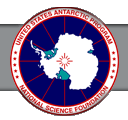Lake Bonney Expedition 2009
The second deployment has been successfully completed.
Full details are available at the
Stone Aerospace ENDURANCE 2009 Blog.
You can learn more about current events from Kristof Richmond at
Kristof's blog
and from Emma Steger at Emma's
blog and from Shilpa Gulati at
Shilpa's blog.
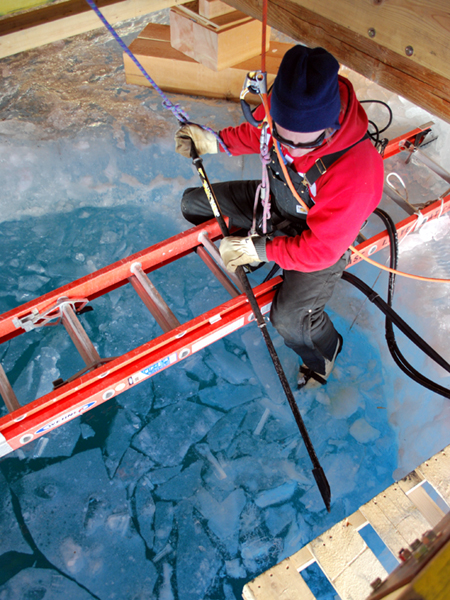
Wearing a harness for safety, Jim breaks up the ice that has formed on the surface of the melt hole.
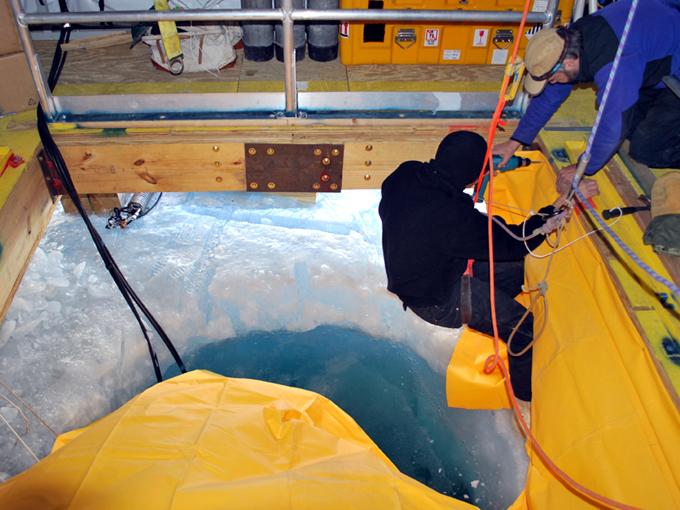
Bill and Bart attach the windbreak fabric to the edge of the floor's moon pool.
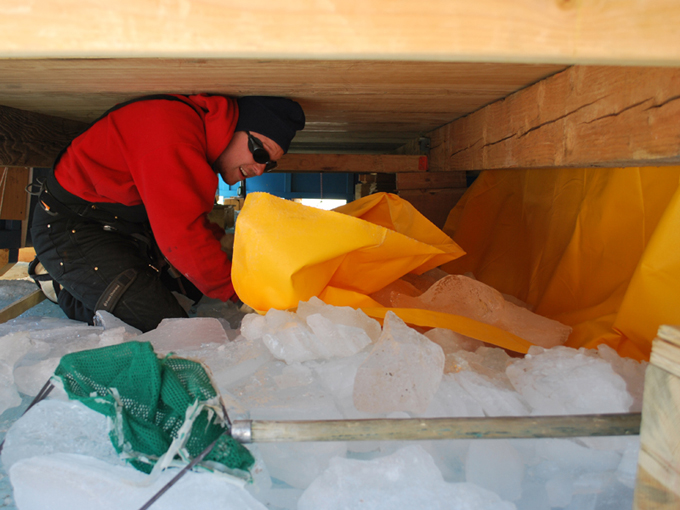
Jim stacks blocks of ice on the windbreak fabric to anchor it down.

Not having a lot of entertainment options for off-time (nor costumes for Halloween festivities), Chris decided to dress up the team by way of crayon drawing!
Saturday
October 31, 2009
Halloween at Lake Bonney!
After a filling breakfast of pumpkin pancakes, compliments of Emma, we hopped on the ATVs for the morning commute to the Bot House. To give the Halloween morning a spooky feel, we made a pit stop to look at two of the many frozen, mummified seals on the east lobe of the lake (for more about these guys, see November 29 of last year's blog).
Upon arriving at the Bot House, Chris, Kristof, Bart and Vickie worked through the pre-dive checklist for the bot in preparation for its first dunk while Bill, Jim, and Maciej went about clearing the layer of ice that had re-frozen over the melt hole. Once this inch-thick skin and the Hotsy melt fingers were removed, it became apparent that the hole was still not quite big enough. The bot has a diameter of just about 7 feet and the hole had a bulge of ice on one side that made it an oval rather than a circle.
After chipping at the bulge for a minute or two with little success, Jim decided to restart the Hotsy fingers and put them to work melting out the bulge. After a minute or two of watching the water surface re-freeze before our eyes, even as the Hotsies were chugging away, we decided to employ some more advanced strategies. The floor Bot House sits about 1 meter above the surface of the lake ice so the melt hole is fairly exposed to the cold wind gusting up and down the valley. The wind also chills the interior of the House, particularly when we have the moon pool cover (a sturdy plywood panel on rails) open to allow access to the melt hole. What we needed was something to cut the wind so we took some 2.5 x 2.5 m pieces of heavy, coated fabric and fastened it to the perimeter of the moon pool. To anchor the bottom of the fabric, which was now flopping in the wind, Jim crawled under the floor, pulled the excess fabric away from the hole, laid it flat on the ice and covered it with chunks of ice that had been chipped out of the hole.
Now that the bot dunk-worthy and the hole has a little more insulation from the elements we just have to let the Hotsies do their thing and return in the morning.
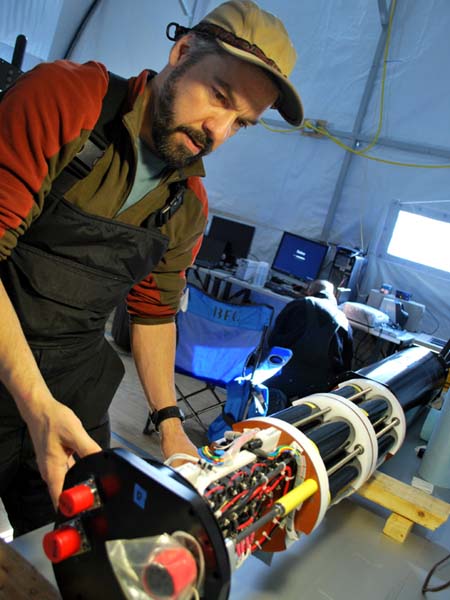
Bart gives the new batteries a final once-over before closing them up in water-tight housings.
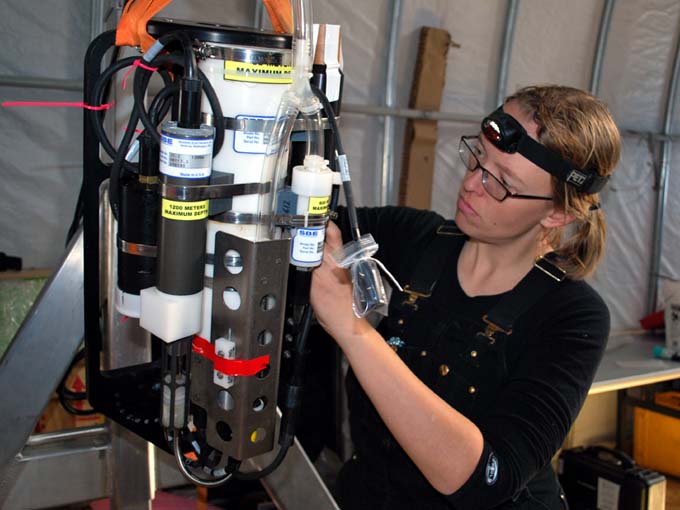
Vickie ties up loose cables on the sonde.
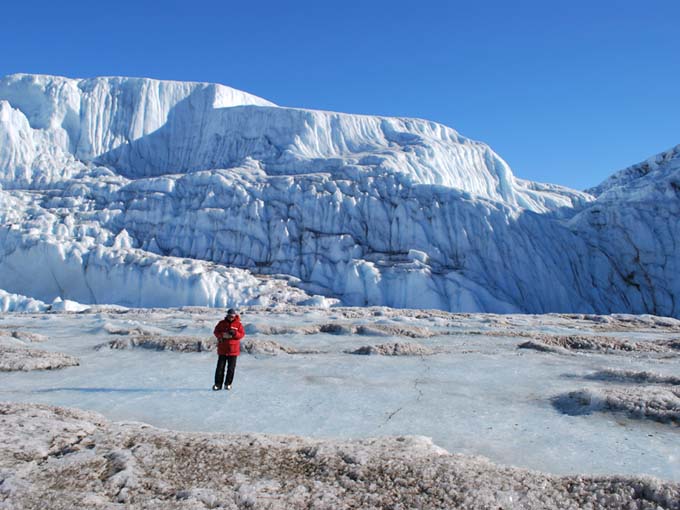
Maciej notes the location where he and Jim will start melting a second hole, about 30 meters from the Taylor Glacier.
Friday
October 30, 2009
The "morning" (we now have 24 hour light - just some hours are dimmer than others because the surrounding peaks shadow the valley) brought the clearest blue skies we've yet had this year. It was somewhat warmer, only -14C, and the sun shone brightly as we commuted to work. We found the center of West Lake Bonney considerably more empty than yesterday - all of the carps but Mombok had helicoptered out early this morning. Maciej and Jim continued work on the melt hole - it is now an oval approximately 2.5m x 2m. It needs to reach a circle 2.5 m in diameter before we can send the bot down.
The morning was spent cleaning up the bot house and reorganizing following the arrival of a dozen tables from McMurdo along with a telcom team that installed a solar powered internet link to the Bonney Riegel repeater station. Mission Control was set up and projection screens installed for the main vehicle status, situational awareness, and science instrument displays. The last of the sensors were installed on the vehicle and the second battery was loaded. Around 6pm the vehicle was put on charge while Kristof read off a checklist of all electrical connectors for inspection. Several of us went around the vehicle and checked over a hundred connections while Vickie performed the final assembly of the science payload sonde sensor suite.
Around mid-day Bill and Maciej drove 400 meters over to the edge of Taylor Glacier to determine a suitable location for an access hole for the vehicle. The idea is complex and will be described in detail later as the mission unfolds, but basically we will drive under the ice to this auxiliary hole and re-ballast the vehicle so that it is capable of exploring under the hypersaline chemocline at 14m depth. The water density shift at that point is so pronounced that the current vehicle would bob like a cork on water at that interface and only an additional 250 kg of ballast will allow it to submerge. We have a permit to take the vehicle beneath the chemocline only at this location. The plan is to then lower the vehicle into the chemocline (using a portable hoist) and release it, at which point it will map the bottom of the lake leading into the glacier. We believe that there is a possibility of a substantial cave under the glacier at the center point of the lake but only an actual exploratory mission will prove this out.
With some luck the bot house melt hole will be large enough by tomorrow to perform the traditional "dunk" test to check out vehicle integrity.
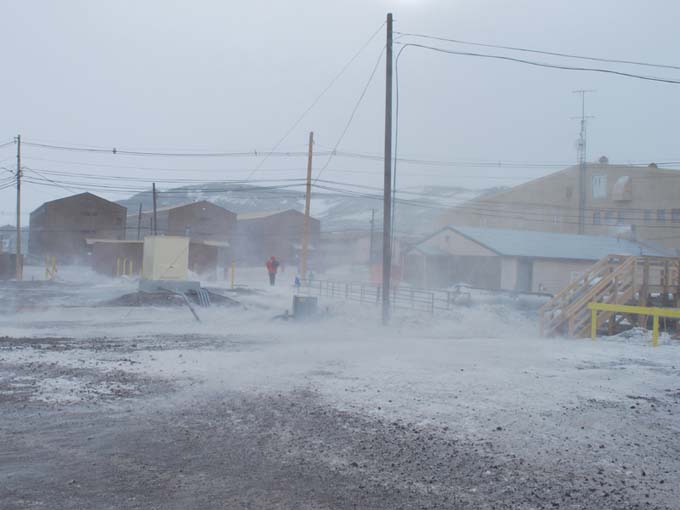
Condition 2 storms grounded most of the team in McMurdo for several days.
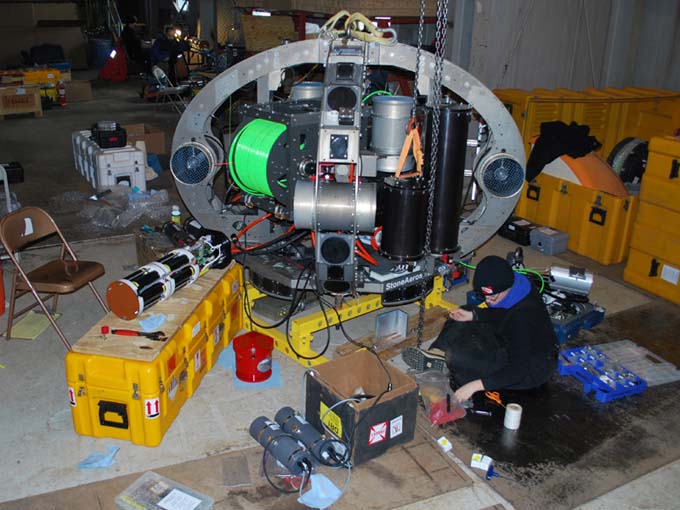
Work continues in the Incinerator. Vickie installs a new mount for the Delta T and the bot is plugged into the new batteries (on orange crate, left) for the first time.
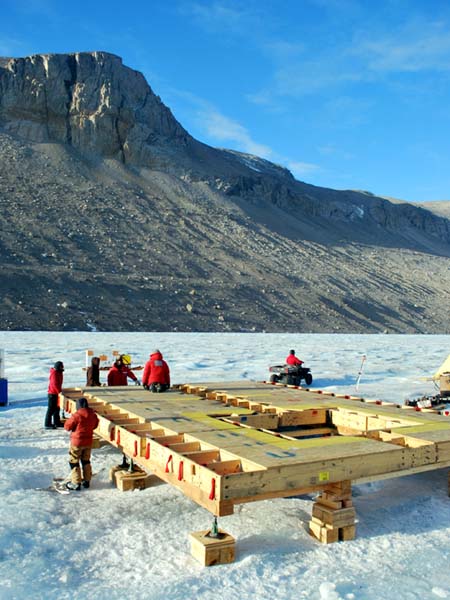
Bill and a team of carpenters work to assemble the floor of the Bot House on Lake Bonney while the rest of the team is wrapping up work in McMurdo.
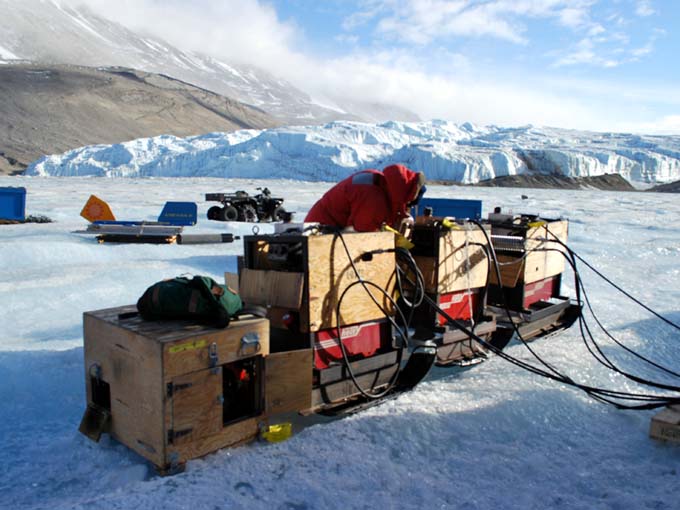
Jim maintains the Hotsy devices that are melting the bot's hole in the ice.
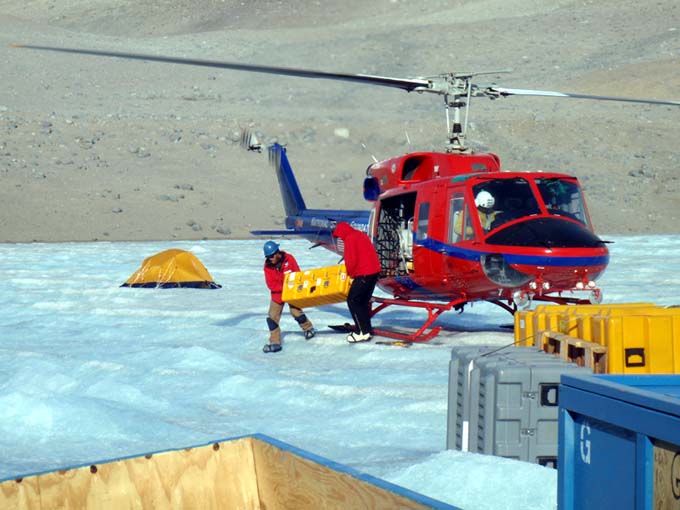
Our new batteries arrive at West Lake Bonney as an internal helo load.
Thursday
October 29, 2009
The past week has been a blur. Bill Stone shipped out to East Lake Bonney main camp on Friday October 22 to guide the assembly of the Bot Garage foundation while the remaining SAS crew continued bot checkout and assembly at the incinerator building at McMurdo. Ten carpenters ("carps") from McMurdo led by David "Mombok" Story had already flown out to West Lake Bonney the previous day and were camped in an array of small tents on the ice around the melt hole. They had also constructed two "Jamesway" huts (3 x 4 meter half-cylinder habitats made by Weather Haven) and were using those for a mess hall and work shop - environmental regulations do not allow any kind of contaminant to be released in the Dry Valleys so wood sawing has to take place indoors and be vacuumed up. About this time bad weather set in again with strong winds (katabatics) coming down off the Antarctic ice sheet, hitting 30 knots in Taylor Valley, driving wind chill down below -35F. Helo ops stopped for close to two days and the bot did not arrive until Tuesday morning. By that time the overall crew of 15 (in addition to the carps there were Maciej Obryk, Jim Olech, Emma Steger, Loralee Ryan, and Bill Stone) had worked two days to get the lab foundation set out and leveled. Then came the heavy lifting of getting all 16 segments loaded and bolted up, with around 300 connections to be made.
Life in Taylor valley is cold. Each morning we have to commute 20 to 30 minutes by six-wheeled ATV from ELB main camp to the melt hole (the previous year's camp at Blood Falls is occupied this season by a small team of glaciologists). The coldest it has been, counting wind chill, was -58F. So you have to layer up and cover every square centimeter of exposed skin and wear goggles. Even with all that the ATV driver's thumb controlling the throttle will get painfully cold unless you place a heater pad inside the thumb of the glove. The fastest route between ELB and the ENDURANCE melt hole is by following the "moat" ice -- a rim of smooth ice surrounding the edges of the lake about 5 to 10 meters in width. The rest of the lake is a series of up to 1 meter high wind blown ridges and troughs that make cross-lake traffic tedious, slow, and bumpy even in a six wheeled vehicle. The moat ice is frequently a criss cross of crack patterns (not unlike the moon Europa's surface), some of which are up to 15 cm wide and demand attention while driving.
Maciej and Jim have spent the past week running up to four "Hotsy" melt systems - complicated and noisy devices that burn "mogas" to heat glycol which runs through a spiral shaped stainless tube that hangs in the water, slowly enlarging the hole through which ENDURANCE must fit to gain access to the sub-ice lake. Each Hotsy also requires a large generator to power its electric pumps to push the hot glycol through the tubes, so at times the cacophony is the only thing you can hear near the melt hole. These two have been putting in a relentless around the clock effort since the heaters require recharging every four hours, day and night. With some luck the hole will be finished tomorrow.
The morning of October 27 was clear and almost dead calm. Helo ops was back up and delivered the bot with pin point accuracy, landing it on top of the completed platform. A few hours later the remaining six SAS crew (Vickie Siegel, Bart Hogan, Kristof Richmond, Shilpa Gulati, Chris Flesher, Rachel Price) arrived on a Bell 212 at the melt hole. By this time half of the large Weather Haven hemisphere frame was up and in place. By 5pm we had the frame complete and began pulling up the multiple layers of over shell - first an inner layer, then 18 overlapped insulation layers and the final exterior weather layer. Each of these required ropes to be tossed over top of the 8m high arch in order to pull the sheets over and tie them down. By then the wind was picking up again and just managed to get everything tied down before gusts were back in the 15 to 20 knot range coming up the valley.
The next two days (October 28 and 29) were spent finishing off the interior of the bot house (getting heating up and running, getting the electric power installed - a 10 kW diesel generator this year) and beginning the unpacking of ENDURANCE gear. By the evening of October 29th most of the vehicle sensors were installed, the profiler servo motors were in place, and one of the new upgrade batteries was completed and loaded into its waterproof housing.
Scheduled for tomorrow: initial power up of the bot for a full systems and sensor integrity check and scouting the location for the sub-chemocline glacier face access melt hole.
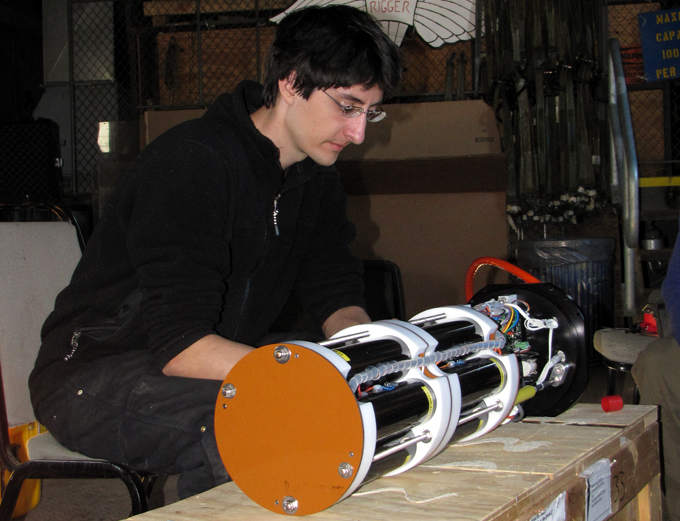
Chris checks out the wiring on one of the bot's new batteries.
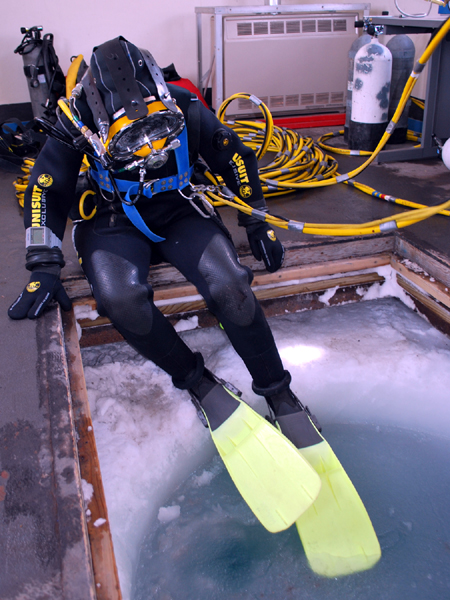
Vickie Siegel enters the icy seawater.
Monday
October 19, 2009
Over the past week we have continued to make preparations for our field work at Lake Bonney. Maciej, Jim, and Loralee flew out to our camp on East Lake Bonney several days ago. They have been preparing camp for the rest of the team and have been melting an 8 foot diameter hole in the ice that will allow us to deploy Endurance in the lake.
Back in McMurdo, Chris, Vickie, and Emma have been joined by other members of the Stone Aerospace team: Bill Stone, Bart Hogan, Kristof Richmond, Shilpa Gulati and Rachel Price. This influx of troops has made The Incinerator a much livelier place. We are currently working to make sure that we deal with any Endurance maintenance, software, or upgrade issues here in McMurdo before the bot is shipped out to the field. A few problems have been encountered but we are steadily working through them and are still on schedule. Thus far we have plugged in all sensors and established that they are working. Chris has been working in the cPCI (the bot's main computer), swapping out an old hard drive for a bigger one, installing an additional hard drive, and rewiring the cPCI's connection to bot's multibeam sonar unit, the Delta T, to allow us to view this sensor's high-quality sonar data on our mission control monitors in real time.
While inspecting the vehicle, Rachel noticed that one of the six thrusters was leaking vegetable oil. The thrusters are pressure-filled with this biodegradable oil to keep water from leaking in, so it is important that that pressure be maintained. Upon removing the thruster we saw that it is leaking from the cable that runs from the thruster body to the motor electronics pod. We're not sure why it suddenly began leaking but the most likely answer is that some part of the connector expands and contracts with temperature changes differently than the part it mates to. Since the bot had a nice cold, exposed ride on a trailer down to the warm, sheltered Incinerator, it recently went through some drastic heat changes, which may have caused the leak. Fortunately, we have a spare thruster that we can swap in. We also ordered some replacement oil and parts from the states for the leaky thruster and these arrived today with Shilpa, the final SAS installment to Team Endurance for this year.
Another system we have been working on is the vehicle batteries. The batteries the robot used last season are the same batteries that were used for the DepthX vehicle, are 4 years old, and have seen a lot of action. They are large, custom designed batteries using lithium ion cells and they are rechargeable. However, like any rechargeable battery, they degrade over time and eventually they will become unusable. Anticipating this degradation, Stone Aerospace used some upgrade funding from NASA to design and build two new batteries. We built these new batteries in August and shipped them down to McMurdo soon after. Chris and Bart have been busy finishing various wiring odds and ends on these batteries and soon they should be ready to test on the vehicle. The plan is that we'll use these new, more powerful batteries for all of the Endurance missions this year and we'll have the old batteries on standby as back-ups. While the old stacks were charged a few times over the winter by a technician here in McMurdo, they were still in pretty bad shape (very low charge and in a few cases individual cells even had negative charge) when we arrived to retrieve them, thus, we are now working to carefully and slowly bring them back up to full charge, if possible.
We also continue to get up to speed with living and working in Antarctica. All of the new arrivals have gone through their intro briefings. Since Rachel and Emma weren't here on the Ice with us last year, they had to go through Happy Camper School, where newbies learn cold weather survival skills for 2 days and spend the night camped out in the snow. In the meantime, Vickie and Bill, accompanied by McMurdo's dive coordination officers, each did a dive under the sea ice in McMurdo Sound. The extremely cold water (about -1.9°C or 28.6°F) means that divers here typically use drysuits, full face masks and surface-supplied air. These check-out dives, in addition to extensive training completed in the states, qualify Vickie and Bill to serve as divers for the Endurance project. As such they will be able smooth any sharp corners around the bottom edge of the ice hole to prevent damage to the bot and to swim a short distance to the bot and attach a tow rope in the event of a minor mishap.
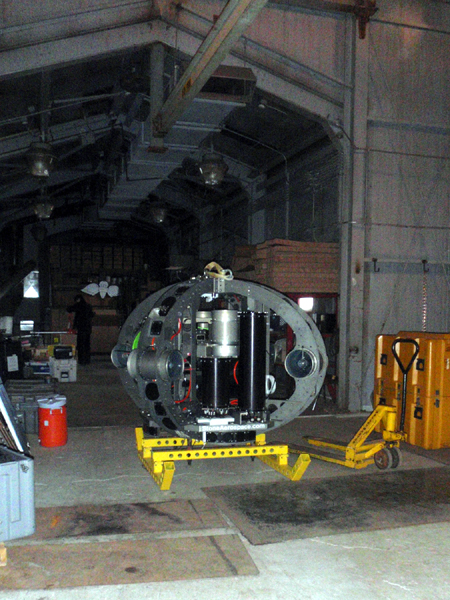
The bot now resides in The Incinerator building. We like to think that robot adds some class to the joint.
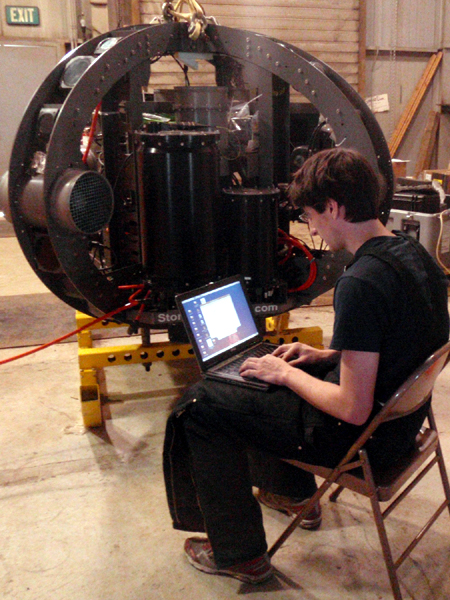
Chris is able to communicate with the bot!
Saturday
October 10, 2009
The last few days have been busy. The first wave of Team Endurance has been dealing with the practical aspects of living and working on the Ice. Nearly every facility we use around McMurdo station and in the field requires an orientation briefing. In addition to these, we've attended refresher courses in cold weather survival, ATV and generator operation, communication equipment and protocols, and so on. In between briefings, we've been getting our in-town lab space set up for the robot.
To avoid costly shipping charges, at the end of our field season last year we stored the bot in McMurdo, instead of sending it back to the states. So here, a giant grey orb amidst a yellow sea of snowmobiles, Endurance has waited all winter in the station's Mechanical Equipment Center building. Now we have moved the bot to a building that is called - for reasons unknown to any of us - The Incinerator. The Incinerator is to be our lab/work space for the next week as we prepare the bot and our new batteries for the field. We've moved the bot into the building and a crew of janitorial staff came out to give the space something of a deep cleaning, since the last thing we want is to get grit into any of the electronics or into the water-tight seals on the vehicle.
Since the bot has been sitting completely inactive since early January, Chris's first task was to see if the main computer would boot. There was no reason that it shouldn't - still, conventional wisdom says that if you leave your car parked in one place for 10 months without driving it, there are a number of reasons it may well not start when you come back. Fortunately, Chris was able to boot the robot up yesterday. Now we will connect all of the sensors that aren't currently mounted on the vehicle to check that they, too, are functionally correctly.
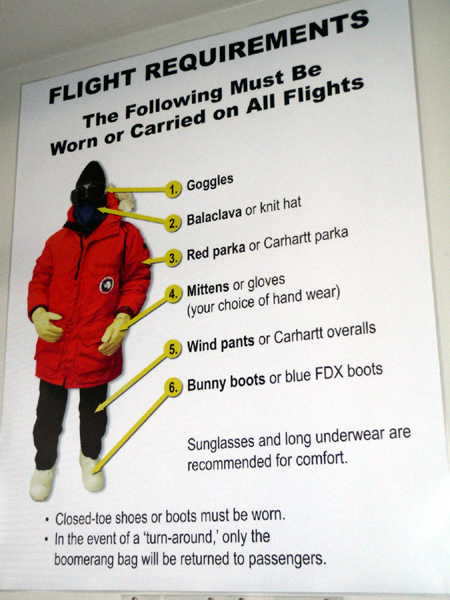
This poster shows some of the cold weather gear that researchers and support workers get from the Clothing Distribution Center.
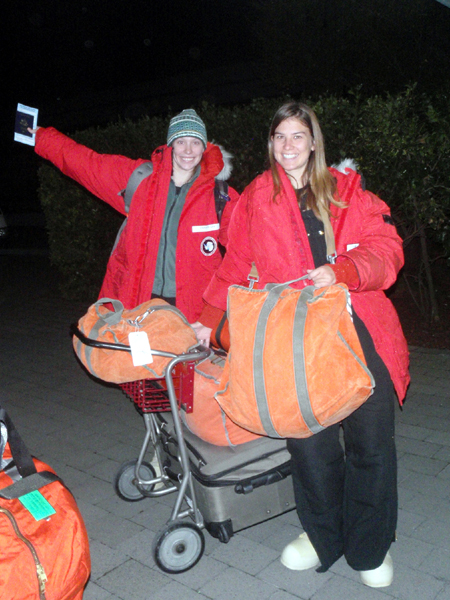
Emma and Loralee break in their Big Red parkas while waiting in line for flight check-in.
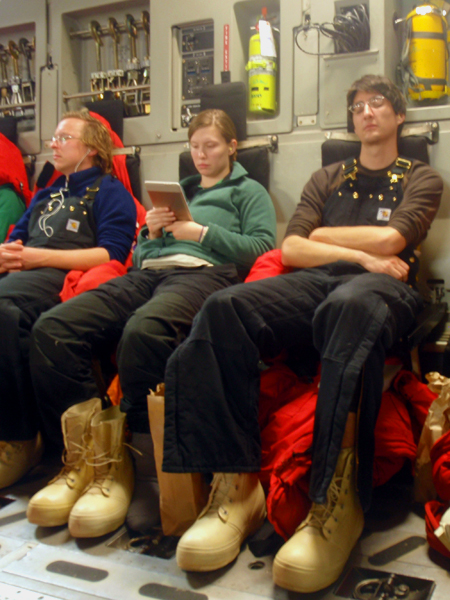
Jim, Emma, and Chris employ different strategies to pass the time on the 5 hour flight..
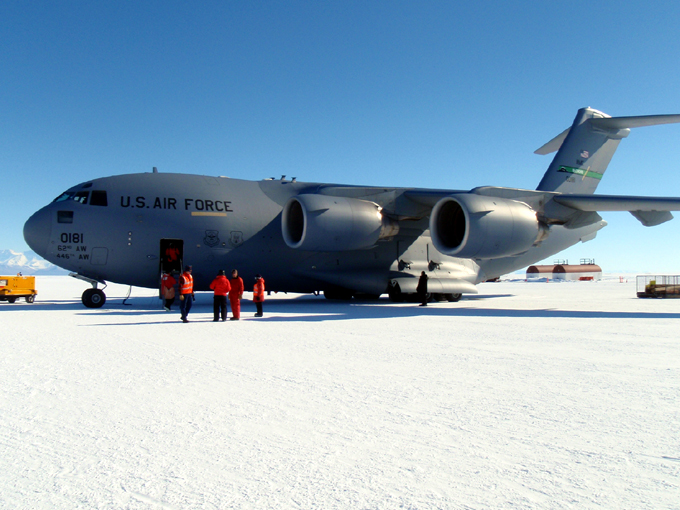
The C17 has landed; we are on the Ice.
Tuesday
October 6, 2009
The Endurance 2009 mission is underway!
Chris Flesher and Vickie Siegel left the States on Friday night and
arrived in New Zealand on Sunday after a twelve-hour flight (ponder
that one for a second ...). From there it was on to Christchurch, the
city on New Zealand's south island where the United States Antarctic
Program (USAP) stages the logistics for running the McMurdo and South
Pole research stations.
The next day we went to the Clothing Distribution Center and were
issued ECW (Extreme Cold Weather) gear. This is all of the stuff that
keeps one alive in Antarctica - things like long underwear, thick
socks, snow goggles and so on. The two most important items are the
voluminous parka, fondly referred to by all as "Big Red", and the super
warm "bunny boots" (more on those later). We received the requisite flu
shots (disease spreads quickly in Antarctica's close indoor quarters)
and sorted luggage for the flight to the ice the following day.
On this CDC visit we were reunited with Maciej Obryk, good friend and
Endurance teammate from University of Illinois at Chicago. Boisterous
greeting and catching up followed and Maciej introduced 3 new folks we
would be working with at Lake Bonney this year: Jim Olech, who will be
assisting Maciej with his Long Term Ecological Research (LTER) at the
lakes this year; Loralee Ryan, who, after a brief stint of helping the
Endurance team, will be working on John Priscu's Limno team; and Emma
Steger, who will be the East Lake Bonney camp manager this year.
After a group dinner we were off to bed, excited to be heading back to
the Ice the next day. We all awoke around 4:30 am to a chilly, dark
morning and hopped on the shuttle back to the CDC, where the C-17
military jet leaves for McMurdo. We groggily finished sorting our
luggage for the flight, weighed ourselves and our baggage for the
flight manifest, sat through some briefings, ate breakfast and
generally milled around before the flight. Despite the early hour,
there was a festive air in the crowd of 130 support personnel and
scientists heading down to the Ice. Chris likened the scene to a really
big family reunion, one where you don'ht know everyone but you recognize
many faces, do a lot of gabbing and catching up, and find that everyone
is generally ready to enjoy the times ahead.
As of this writing, we are about halfway through the 5 hour flight.
About a third of the group is snoozing. Others are reading, rocking out
to their mp3 players, or pursuing half-shouted conversations over the
engine roar. More briefings await us this afternoon and there are
trainings to attend tomorrow. That done, we will be reunited with the
Endurance robot, which has been safely stored away in McMurdo over the
Antarctic winter, and work will begin!
Personnel:
Dr. Peter Doran is the
Principal Investigator for the Endurance
project. He has been studying the lakes in the Antarctic Dry Valleys
for 15 years and is a professor at the University of Illinois, Chicago.
Dr. Bill Stone is a
Co-Investigator for Endurance. He is also the
president and CEO of Stone Aerospace, the engineering company that
designed and built the Endurance vehicle.
Dr. John Priscu is a
Co-Investigator from the University of Montana. He
has been studying the lakes in the Antarctic Dry Valleys for over 20
years.
Bart Hogan is a mechanical
engineer for Stone Aerospace.
Dr. Kristof Richmond is a
programmer for Stone Aerospace, focusing on
navigation.
Shilpa Gulati is a programmer
for Stone Aerospace, focusing on the
system executive and machine vision. She is also a PhD student at
University of Texas, Austin.
Chris Flesher is the vehicle
manager, programmer, and electronics
technician for Stone Aerospace. He is a Masters student at UT Austin.
Rachel Middleton Price is an
electronics
technician for Stone Aerospace.
Vickie Siegel is chief vehicle
technician and logistics manager for Stone Aerospace.
Maciek Obryk is a graduate
student at the University of Illinois at Chicago.
Emma Steger is the Lake
Bonney camp manager.


